
Top 10 AI Essay Writing Tools for Students and Professionals
Struggling to keep up with writing assignments or professional documents? AI essay writing tools can save you time and improve your work.
Here’s a quick summary of the best tools available:
- Yomu AI: Great for academic writing with features like text generation, citation management, and plagiarism detection.
- Grammarly: Perfect for grammar and style checks, tone adjustments, and professional communication.
- QuillBot: Offers paraphrasing, citation generation, and plagiarism detection for research papers.
- Scribbr: Focused on academic citations, plagiarism checks, and proofreading.
- ProWritingAid: Ideal for style improvement with advanced editing tools.
- Jasper AI: Best for long-form content and professional collaboration.
- Paperpile: Simplifies reference management and integrates with Google Docs.
- Zotero: Excellent for organizing research and managing citations.
- Turnitin: Industry leader in plagiarism detection and academic integrity.
- WriteSonic: Fast essay generation with templates and multilingual support.
Quick Comparison
| Tool | Key Features | Plagiarism Check | Citation Tools | Free Option | Monthly Price (USD) | Best For |
|---|---|---|---|---|---|---|
| Yomu AI | Text generation, citations | ✓ | ✓ | - | Contact Sales | Academic writing |
| Grammarly | Grammar, tone, style | ✓ | - | ✓ | $12-$30 | General writing |
| QuillBot | Paraphrasing, citations | ✓ | ✓ | ✓ | $14.99 | Research papers |
| Scribbr | Citations, proofreading | ✓ | ✓ | - | Custom Pricing | Academic citations |
| ProWritingAid | Style editing | ✓ | - | ✓ | $20 | Style improvement |
| Jasper AI | Long-form writing, templates | - | - | 7-day trial | $49 | Professional writing |
| Paperpile | Reference management | - | ✓ | 30-day trial | $36 | Reference management |
| Zotero | Research organization | - | ✓ | ✓ | Free | Research organization |
| Turnitin | Plagiarism detection, feedback | ✓ | - | - | Custom Pricing | Academic integrity |
| WriteSonic | Essay generation, multilingual | - | - | ✓ | $16-$79 | Content generation |
Key Takeaway
Choose a tool based on your specific needs - whether it’s citation management, style improvement, or plagiarism detection. Each tool offers unique features to make writing faster and easier.
Best AI Writers for Academics and Research [Start for FREE!]
What to Look for in AI Essay Writing Tools
When selecting an AI writing tool for academic or professional use, it's important to focus on features that align with U.S. academic standards. Here's what to keep in mind:
Advanced Text Generation and Analysis
The most effective tools use natural language processing models to create clear, context-aware content. Many top platforms analyze more than 25 writing metrics.
Grammar and Style Checks
Choose tools with robust grammar-checking capabilities. The best options can identify over 400 types of errors and tailor suggestions to your specific field of study.
Citation Management
Accurate citations are a cornerstone of academic integrity. Look for tools that offer:
| Key Citation Features | Purpose |
|---|---|
| Multiple Format Support | Automatically formats citations in APA 7th edition, MLA, and Chicago styles |
| Database Integration | Allows direct imports from academic databases |
| DOI Management | Validates and formats DOIs automatically |
| Source Verification | Ensures sources are accurate by cross-checking with academic databases |
Plagiarism Detection
Top-tier plagiarism detection systems compare your work against vast databases, including 91 million academic papers and 24 billion web pages. This helps ensure your writing meets originality standards.
User Interface and Accessibility
A user-friendly interface is essential. With 68% of students using smartphones for academic writing, mobile compatibility is a must. Features like clear dashboards, screen reader support, and integration with tools like Canvas and Google Docs make these platforms easier to use. Real-time co-editing features, which are used by 76% of collaborative student projects, further streamline group work.
Data Privacy and Security
Academic data protection is non-negotiable. Look for tools that include:
- FERPA compliance
- AES-256 encryption
- Automatic data deletion policies
- Transparent content ownership terms
- Institutional-level privacy controls
Customization Options
The best tools let you tailor features to your academic discipline. Platforms offering multiple writing modes - from basic essay outlines to detailed research paper formats - are especially useful. Studies show that discipline-specific presets improve accuracy by 40% when adhering to academic writing standards.
Format Compliance
Ensure the tool supports standard U.S. academic formatting, such as:
- 1-inch margins
- Times New Roman, 12pt font
- Double-spacing
- MM/DD/YYYY date format
- Title page templates
- Proper reference page setup
These features are essential when evaluating AI tools for academic writing.
1. Yomu AI
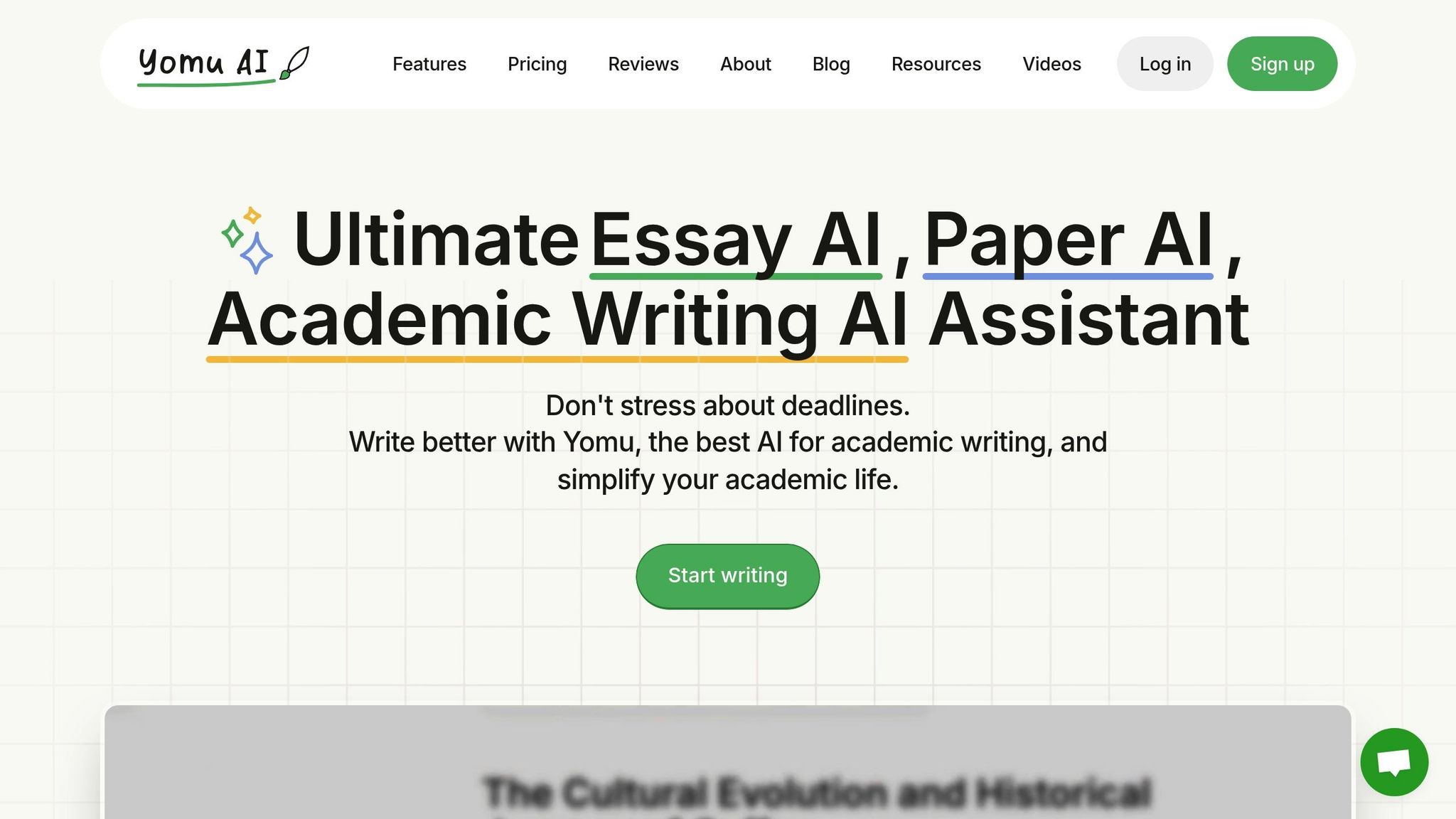
Text Generation Features
Yomu AI provides powerful tools for creating and refining text through its intelligent Document Assistant. Its AI autocomplete feature helps complete sentences and paragraphs while keeping the writing smooth and consistent. The platform also turns simple ideas into well-developed content with its range of features:
| Feature | Purpose |
|---|---|
| Paraphrasing | Improves text for better clarity and a more formal tone |
| Text Expansion | Turns short points into detailed explanations |
| Summarization | Shortens long passages into concise summaries |
| Bullet-to-Text | Transforms bullet points into full paragraphs |
"Yomu.ai allows for the insertion of figures and tables, with the capability to describe their captions in italics. It also features a citation search function, making it particularly efficient for students who are not accustomed to writing papers in journal formats, allowing them to focus on their research content."
In addition to its writing features, Yomu AI makes managing citations and references much simpler.
Citation Management and Formatting
With Sourcely powering its citation tool, Yomu AI streamlines reference management. It supports figure and table insertion and automates caption formatting, making it especially useful for academic and research writing.
"All researchers of all levels need to use Yomu.ai It is by far the best AI writing tool to supplement your existing writing workflow."
Plagiarism Detection
To ensure originality, Yomu AI includes a plagiarism checker that verifies content before submission. Its user-friendly design combines simplicity with professional-grade performance.
"I appreciate Yomu's clean interface, efficient export options, and seamless reference and citation formatting. It has made my work flow much more efficient."
2. Grammarly
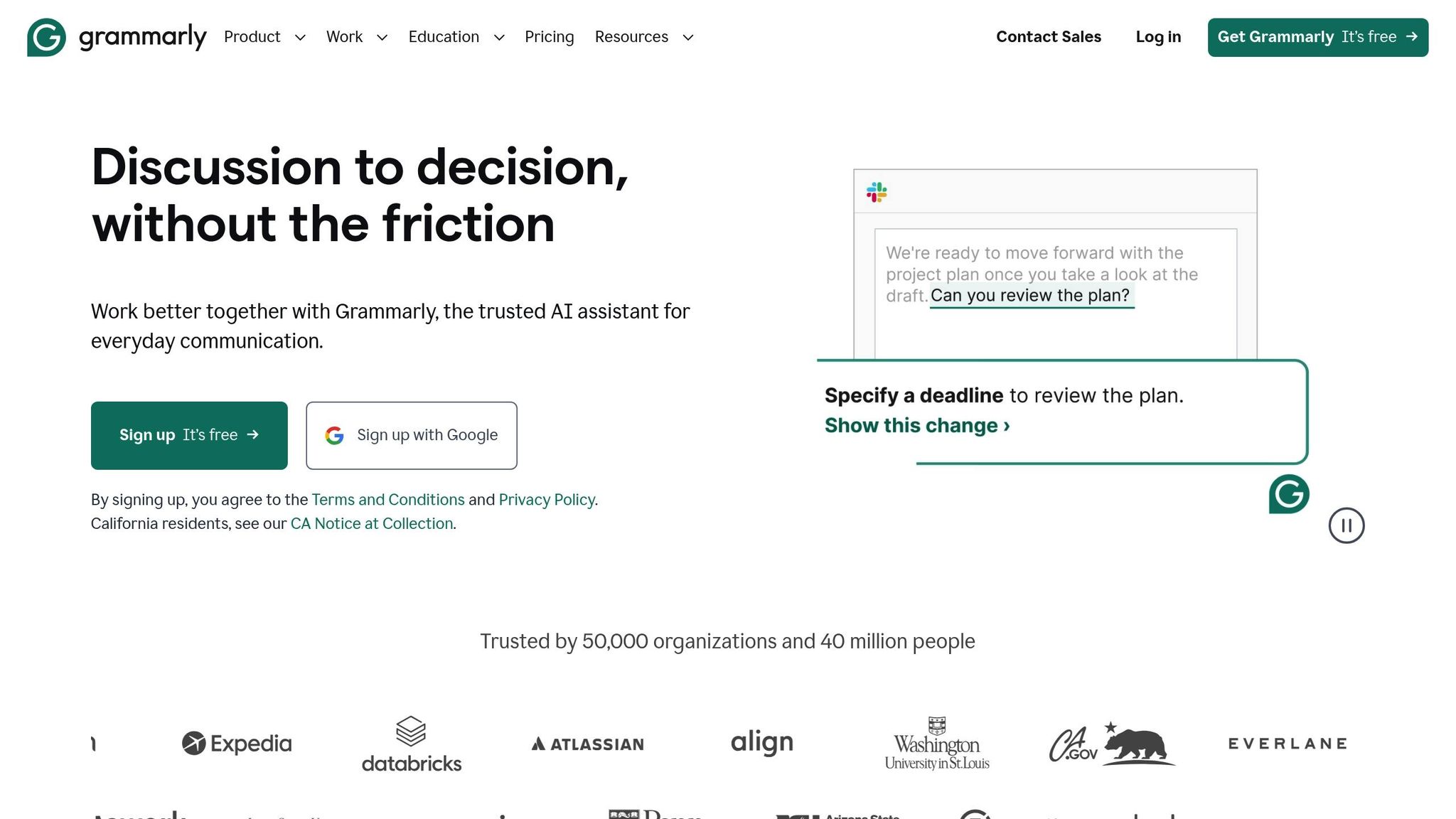
Grammar and Style Checking
Grammarly is a widely-used tool that offers real-time suggestions to improve your writing based on context and audience. It checks for grammar, punctuation, tone, style, and sentence structure, helping you refine your content as you write.
| Writing Element | What It Does |
|---|---|
| Grammar | Fixes grammatical mistakes |
| Punctuation | Corrects punctuation errors |
| Style | Makes writing clearer and more concise |
| Tone | Adjusts tone for professional communication |
| Sentence Structure | Improves sentence flow and readability |
These features are designed to help you create polished, professional content.
Text Generation and Refinement
Grammarly goes beyond fixing errors. It also offers tools to help with:
- Generating outlines
- Rewriting sentences for clarity
- Adjusting tone to match your audience
- Summarizing content effectively
Plagiarism Detection
Grammarly includes a plagiarism detection tool, ensuring your work remains original and plagiarism-free. The tool integrates smoothly with various platforms, making it easy to maintain consistent writing quality. Grammarly is available as a free version with basic features or a Pro version for advanced tools and capabilities.
3. QuillBot
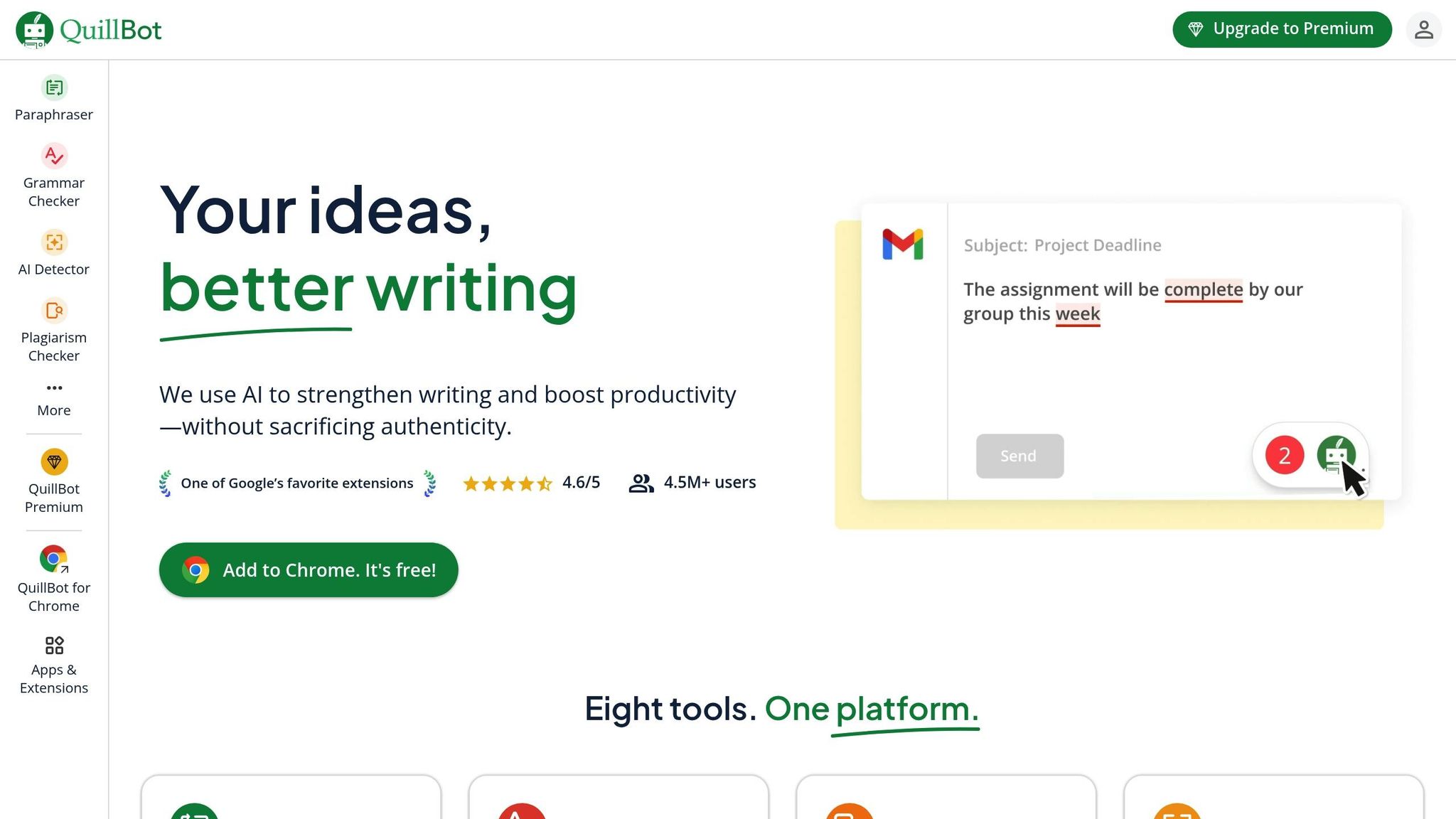
Text Generation and Refinement
QuillBot’s AI-driven paraphrasing tool offers seven modes: Standard, Fluency, Formal, Academic, Creative, Simple, and Expand. With its Synonym Slider, users can control the level of paraphrasing, adjusting intensity from 0% to 100%. This allows for fine-tuning the style while maintaining the original meaning.
"The Academic mode has shown remarkable results, with 82% of student users reporting improved essay clarity in our 2023 trials", notes EduTech Review.
The Co-Writer combines several tools - paraphrasing, grammar checks, research features, and Flow Mode - into one platform, making it a comprehensive writing assistant.
Grammar and Style Tools
QuillBot provides real-time feedback on grammar, punctuation, word selection, and sentence structure. These features help improve overall writing quality.
| Feature | Description |
|---|---|
| Real-Time Feedback | Detects errors instantly as you type |
| Basic Grammar | Covers subject–verb agreement and punctuation |
| Word Choice | Suggests improved vocabulary |
| Sentence Structure | Offers tips for better readability |
Premium users gain access to even more advanced tools and faster processing.
Citation and Formatting Assistance
QuillBot also simplifies academic formatting with its Citation Generator, supporting APA, MLA, and Chicago styles. Users can input a URL, ISBN, or DOI to create properly formatted citations in seconds.
"Always cross-reference QuillBot's citations with your university's style guides, especially for complex sources."
Plagiarism Checker
For those concerned about originality, QuillBot’s Premium plan includes a plagiarism checker. It scans content against 16 billion web pages and ProQuest's academic database. A 2024 analysis found it detects 94% of copied material. The Premium plan, priced at $19.95/month, includes:
- 20 pages of plagiarism checks per month
- Unlimited word processing
- Access to all seven paraphrasing modes
Students can take advantage of a 20% discount on annual subscriptions, bringing the cost to about $79.40/year - an appealing option for those on a budget.
4. Scribbr
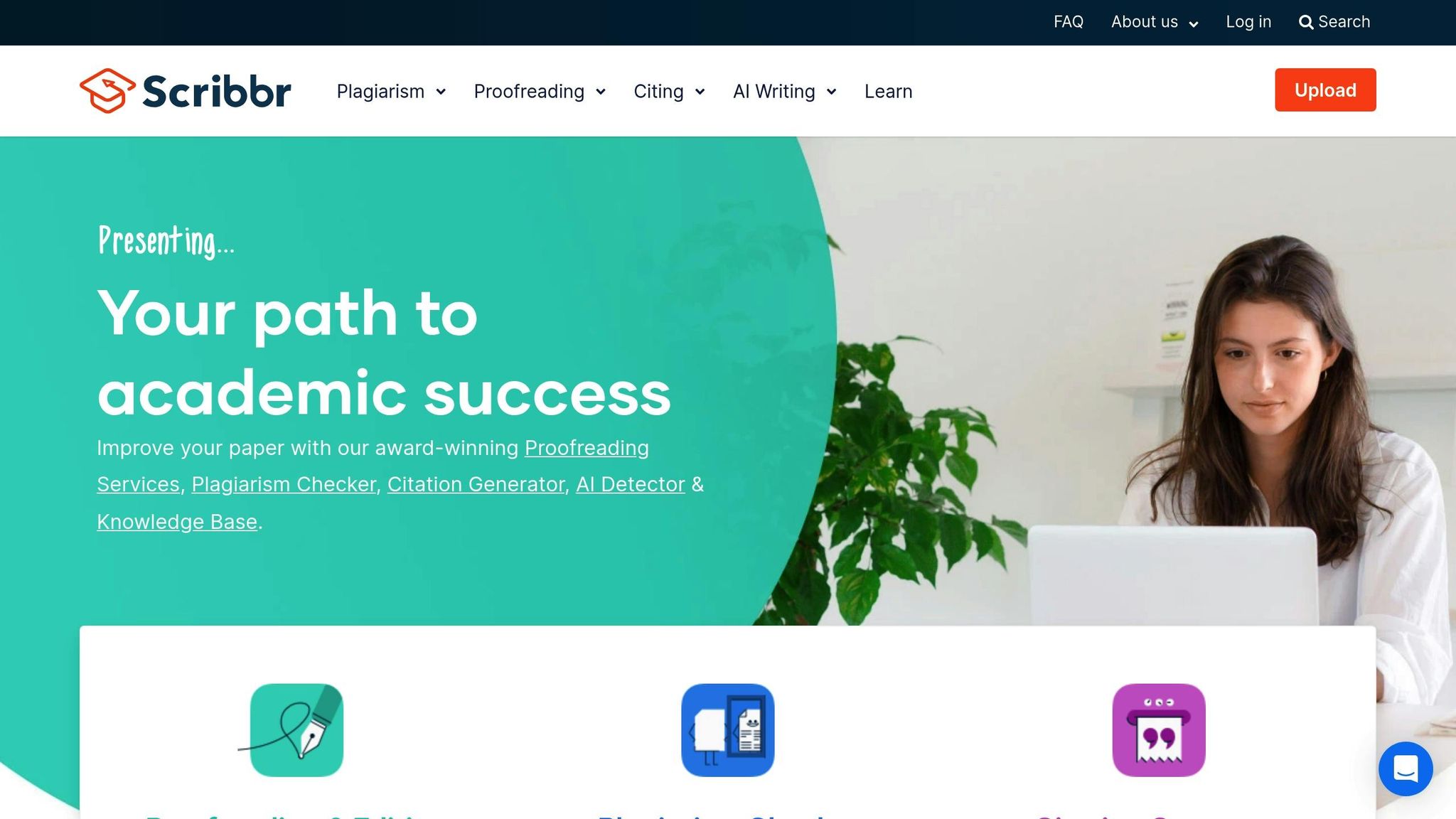
Grammar and Style Checking
Scribbr's academic writing tool combines AI with insights from over 50,000 graded papers. It’s especially effective at spotting discipline-specific issues like overuse of passive voice in scientific writing or improper hedging in research papers. The Academic Tone Monitoring feature ensures a formal tone throughout essays - something Dr. Emily Tran from Stanford University highlights as particularly helpful for ESL students.
| Feature | Focus on Academic Writing |
|---|---|
| Discipline-Specific Checks | Identifies field-appropriate language and tone |
| Argument Structure | Evaluates topic sentences and their alignment with theses |
| Language Precision | Flags vague or unclear academic language |
| Style Consistency | Maintains a formal and consistent tone |
In addition to style checks, Scribbr simplifies citation management.
Citation Management and Formatting
Scribbr’s Citation Generator delivers references with a 99.1% accuracy rate. It verifies publisher details for book citations, updates preprint references in real time, supports over 9,000 publication types, and integrates with Zotero. Many academic users have praised its citation generator and detailed plagiarism reports for improving their writing workflow.
Plagiarism Detection
Scribbr also offers a powerful plagiarism detection tool. It scans content against 99.3 billion web pages and 8 million academic works, thanks to partnerships with CrossCheck and CrossRef. The system provides a detailed breakdown of similarities by source type and can even detect AI-generated content by analyzing syntax patterns.
| Document Size | Processing Time |
|---|---|
| Up to 50,000 words | Under 10 minutes |
To protect user privacy, submitted content is deleted after 30 days. Scribbr also scored 94/100 in the 2024 PrivacyPulse audit, ensuring FERPA compliance.
For $19.99/month, the Student Pro plan includes unlimited plagiarism checks, 2,500 words of monthly proofreading credits, and extra support during finals. Scribbr’s range of tools makes it a valuable resource for students and academic professionals.
5. ProWritingAid
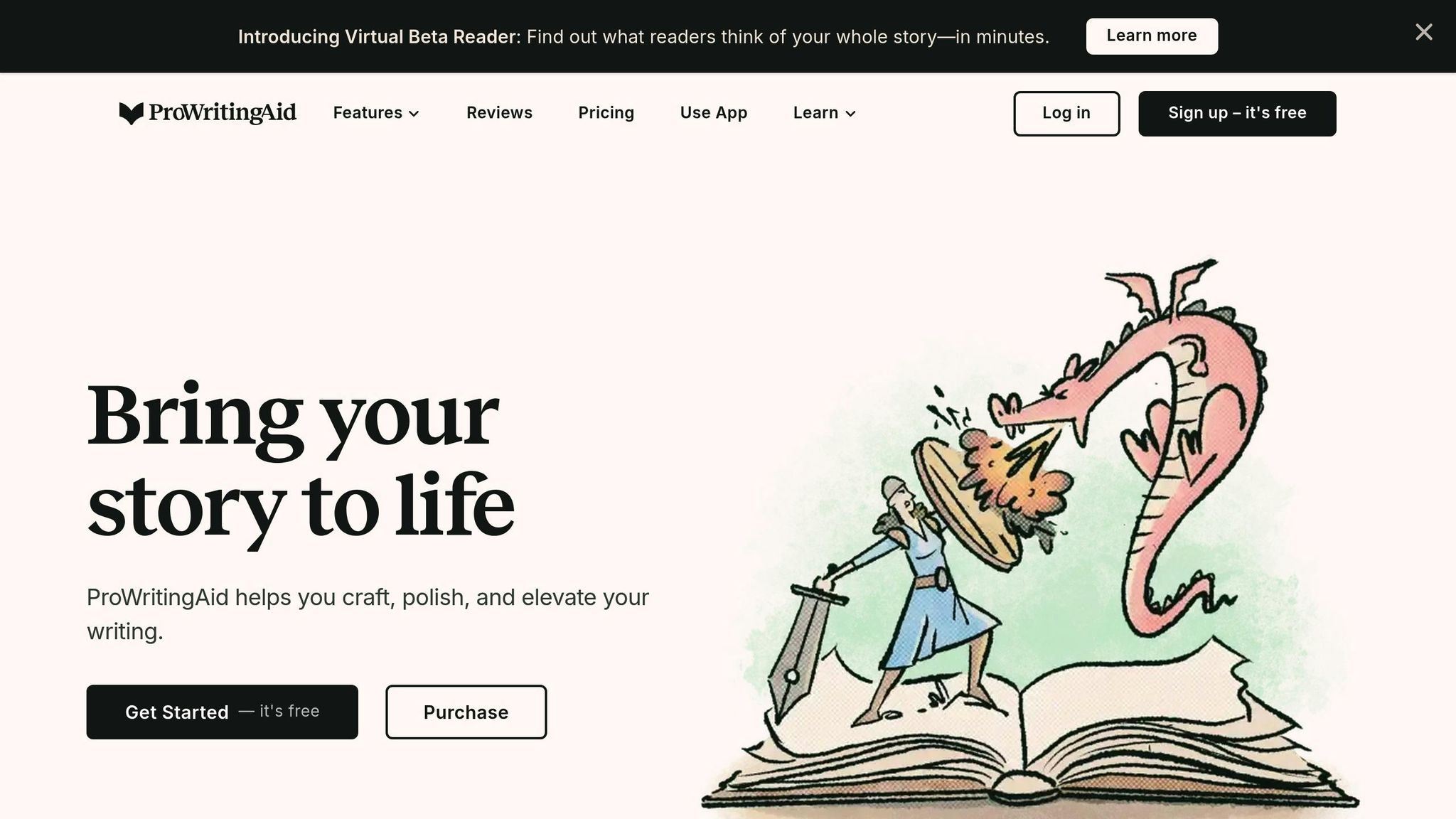
Plagiarism Detection
ProWritingAid includes a plagiarism checker that scans your work against a massive database of over one billion web pages, published works, and academic papers. Accessible through both an online platform and a Microsoft Word add-in, it fits seamlessly into different workflows. Plus, it prioritizes privacy, stating: "ProWritingAid never stores, shares or resells your text".
| Feature | Details |
|---|---|
| Database Coverage | Over one billion web pages and academic papers |
| Max Words per Check | Up to 2,000 |
| Integration Options | Online platform and MS Word add-in |
| Source Attribution | Displays similarity percentage |
| Content Protection | No text storage or reselling |
The tool highlights exact matches and shows similarity percentages by comparing your text to both online and offline sources. It’s designed to catch instances of unattributed content and ensure proper citations. With its strong combination of privacy safeguards and effective detection, ProWritingAid is an excellent option for academic writers.
6. Jasper AI

Jasper AI, like other modern AI writing tools, blends advanced text creation, grammar refinement, and workflow-friendly features.
Text Generation and Refinement
Jasper AI excels in generating content for both academic and professional settings. In a recent evaluation, its narrative scored 82.1 out of 100 across key writing aspects:
| Writing Aspect | Score |
|---|---|
| Grammar | 100% |
| Spelling | 97% |
| Word Choice | 96% |
| Punctuation | 92% |
"Universities need to equip people with the skills for the 21st century, not the 20th. And I think that's why AI tools should be used even in academic settings."
Beyond creating content, Jasper AI ensures precision with built-in grammar tools.
Grammar and Style Tools
After generating text, Jasper AI focuses on polishing it. Its advanced grammar checks are designed to ensure both accuracy and a consistent style.
"Generally the story was eloquently written, even though the plot was rather simple... As I see it, this essay only proves, that an AI writing generator can give you a general idea about the piece, but it needs human refining to become a decent piece of work."
User-Friendly Features
Jasper AI also includes tools that make it easy to integrate into your workflow:
- Browser Extension: Works seamlessly with Google Docs.
- Text Manipulation: Offers rewriting, summarizing, and rephrasing tools.
- Free Trial: A 7-day trial lets you explore its features.
- Flexible Pricing: Plans range from $49/month (Creator) to $69/month (Pro).
With an A*Help Score of 75.7 out of 100, Jasper AI proves to be a reliable option for academic assistance.
sbb-itb-1831901
7. Paperpile
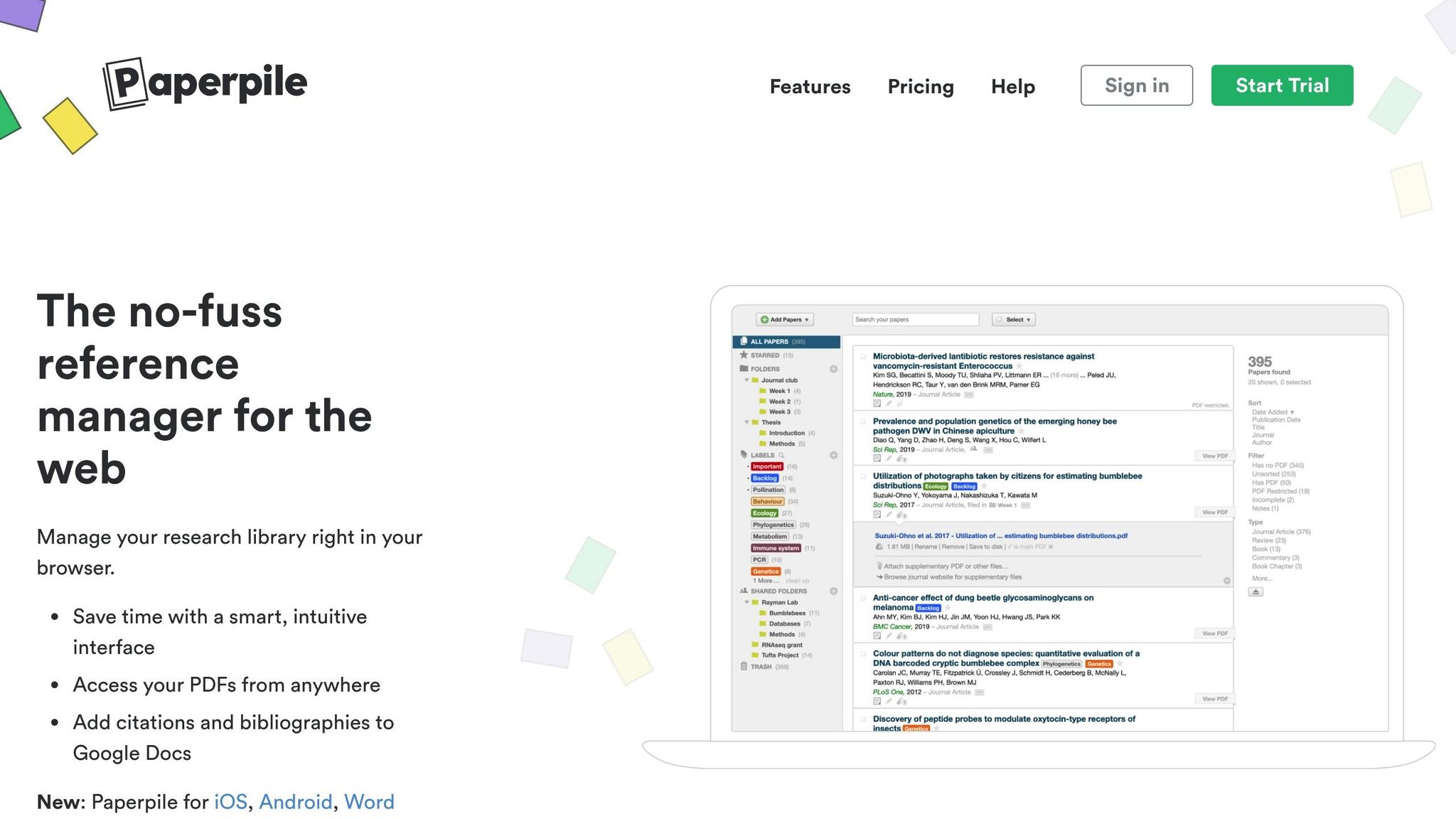
Paperpile is a reference management tool designed to streamline academic writing by integrating seamlessly with popular platforms like Google Docs and Microsoft Word.
Citation Management and Formatting
With support for over 8,000 citation styles through CSL, Paperpile simplifies citation management. Its integration with Google Docs allows users to insert citations in real time and automatically generate bibliographies.
Key features include:
| Feature | Function |
|---|---|
| Reference Types | Supports over 30 types and 86 subtypes |
| Integration | Works with Google Docs and Microsoft Word via plugins |
| Collaboration | Offers shared folders and private sharing links |
| Auto-completion | Fills in missing reference details by searching online |
| Quality Control | Ensures consistent journal names and abbreviations |
Google Docs users can add citations directly through a toolbar icon or keyboard shortcuts - Ctrl-Alt-P (Windows/Linux) or Shift-⌘-P (Mac). Even collaborators without Paperpile can view and edit citations as clickable links. Beyond citations, Paperpile helps keep your documents organized and easy to manage.
"Sometimes I remember there are people who don't use @paperpile for all things paper-related and I wonder how they get things done." - Alex Holehouse
Paperpile also excels at organizing academic materials like journal articles, preprints, conference papers, and patents. Its PDF management system syncs files to Google Drive, supports highlights and annotations, and lets users organize papers using folders, labels, and stars.
"Paperpile has made writing my thesis 23092384x easier. Long live paperpile." - Dr. Emily Jane Dennis
In addition, Paperpile imports references from sources like Google Scholar, PubMed, and ArXiv. It detects duplicate entries to keep your database clean and automatically searches for missing reference details to ensure accuracy.
8. Zotero
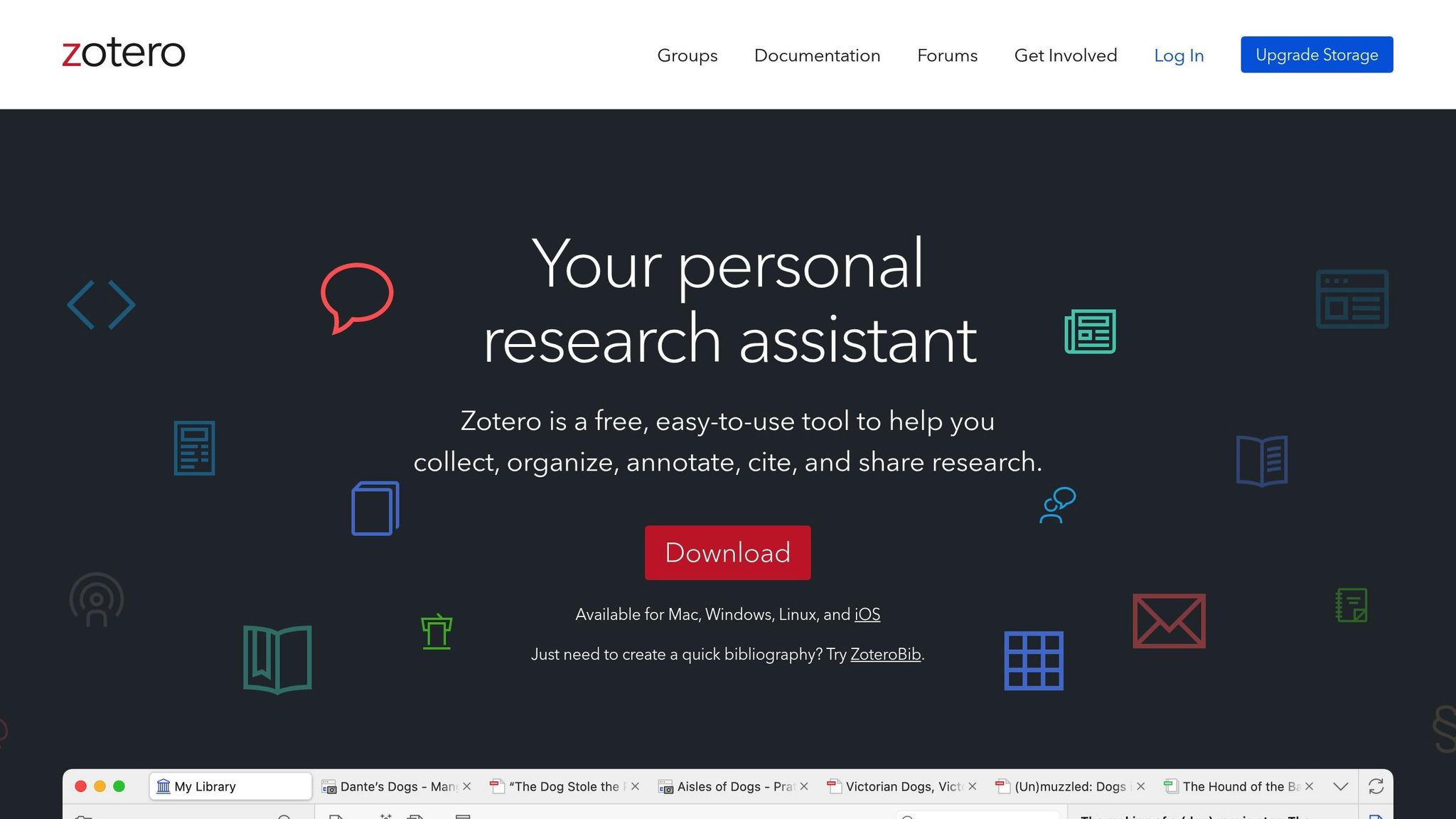
For writers handling academic projects, Zotero simplifies citation management and research organization. While it’s not an AI writing tool, it’s an invaluable resource for students and professionals juggling multiple sources and citations.
Citation Management and Formatting
Zotero supports more than 10,000 citation styles, including popular ones like APA 7th and MLA 9th. According to a 2023 University of Michigan study, students saved 15–20 minutes per paper compared to manually formatting citations. Its seamless integration with word processors makes it even more convenient.
Here’s how Zotero works with major tools:
| Feature | Functionality |
|---|---|
| Word Integration | Add citations directly via toolbar |
| Google Docs | Automatically updates bibliographies |
| Browser Extension | Save sources with a single click |
| Storage | 300MB free, with paid plans for more |
| Group Collaboration | Share libraries with up to 100 members |
A 2024 survey revealed that 89% of graduate students collected sources faster using Zotero’s browser connector.
"Zotero's searchable notes and PDF annotation tools make revisiting sources years later effortless", says Dr. Jane Smith from Harvard.
Zotero is also highly accurate. A 2023 analysis by the Online Writing Lab showed its APA citation accuracy exceeded 98%, outperforming manual entries by 22%. This precision comes from cross-referencing identifiers like DOIs and PubMed IDs.
Beyond citations, Zotero Groups allows teams to collaborate by sharing references and annotations in public or private libraries. The free version provides 300MB of storage, with paid plans starting at $20/year for 2GB.
Zotero also supports citations for modern sources like social media posts and podcasts. This earned it recognition from the Modern Language Association in 2023 for keeping up with evolving research needs.
To get the most out of Zotero, organize your sources with tags and collections, link related materials, and sync your data through Zotero.org. Accessibility features, such as screen-reader compatibility and support for 35 languages, ensure that Zotero is a tool researchers worldwide can rely on.
9. Turnitin
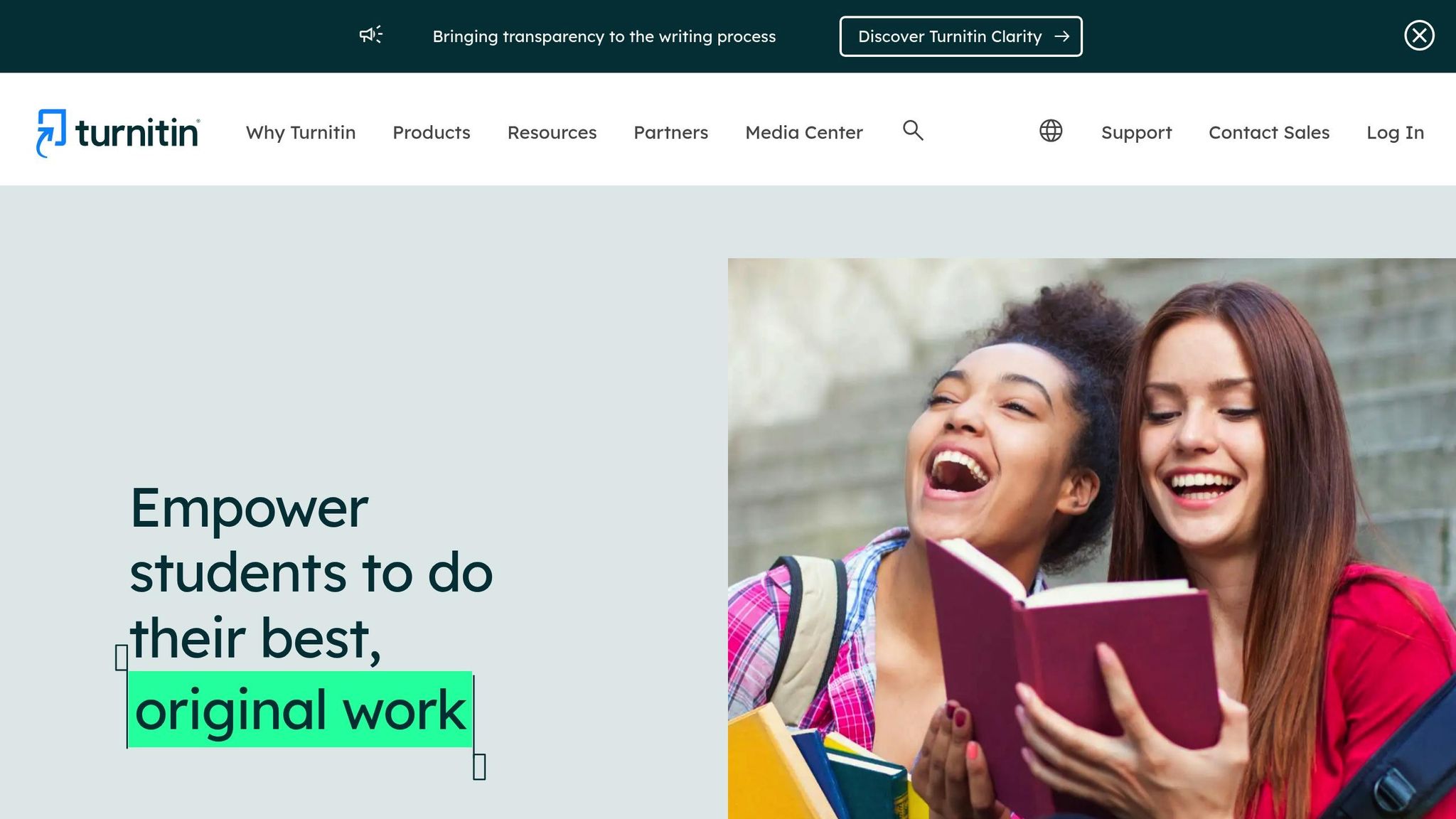
Plagiarism Detection
Turnitin is a widely used tool for maintaining academic integrity, handling 1.2 million submissions daily. It compares content against a massive database of 1.8 billion web pages, 89 million student papers, and 190 million academic articles. Its algorithm calculates a Similarity Score to identify potential plagiarism.
| Feature | Details |
|---|---|
| Database Coverage | 1.8 billion web pages, 89 million student papers, 190 million academic articles |
| Processing Time | 5–15 minutes |
| Detection Rate | 92% accuracy for identifying copied content |
| AI Content Detection | 98% accuracy for GPT-4-generated content |
| Institution Coverage | Used by 98% of top U.S. universities |
Turnitin doesn’t just stop at plagiarism detection - it also helps improve writing quality.
Grammar and Style Checking
Turnitin's Feedback Studio, powered by ETS technology, provides detailed suggestions to improve writing. It flags passive voice, recommends academic vocabulary, and refines overall style.
"For example, UCLA reported a 32% reduction in plagiarism cases after mandating Turnitin submissions."
The tool also identifies citation errors, further supporting academic integrity.
Citation Management and Formatting
Though not a full-fledged citation generator, Turnitin is excellent at spotting citation mistakes and inconsistencies. It cross-checks quoted text with bibliographies to help users avoid accidental plagiarism. The system generates a color-coded report, making it simple to identify and revise problematic areas.
Tips for Best Results:
- Submit drafts early for review.
- Aim for a Similarity Score under 15%.
- Double-check quotation formatting.
- Pay attention to AI-detection flags.
In 2024, Turnitin enhanced its AI detection capabilities, achieving 98% accuracy for GPT-4-generated content. The platform also prioritizes privacy, complying with FERPA regulations and using secure, institution-owned repositories. Submissions are protected through hash encryption, ensuring both security and thorough plagiarism detection.
10. WriteSonic
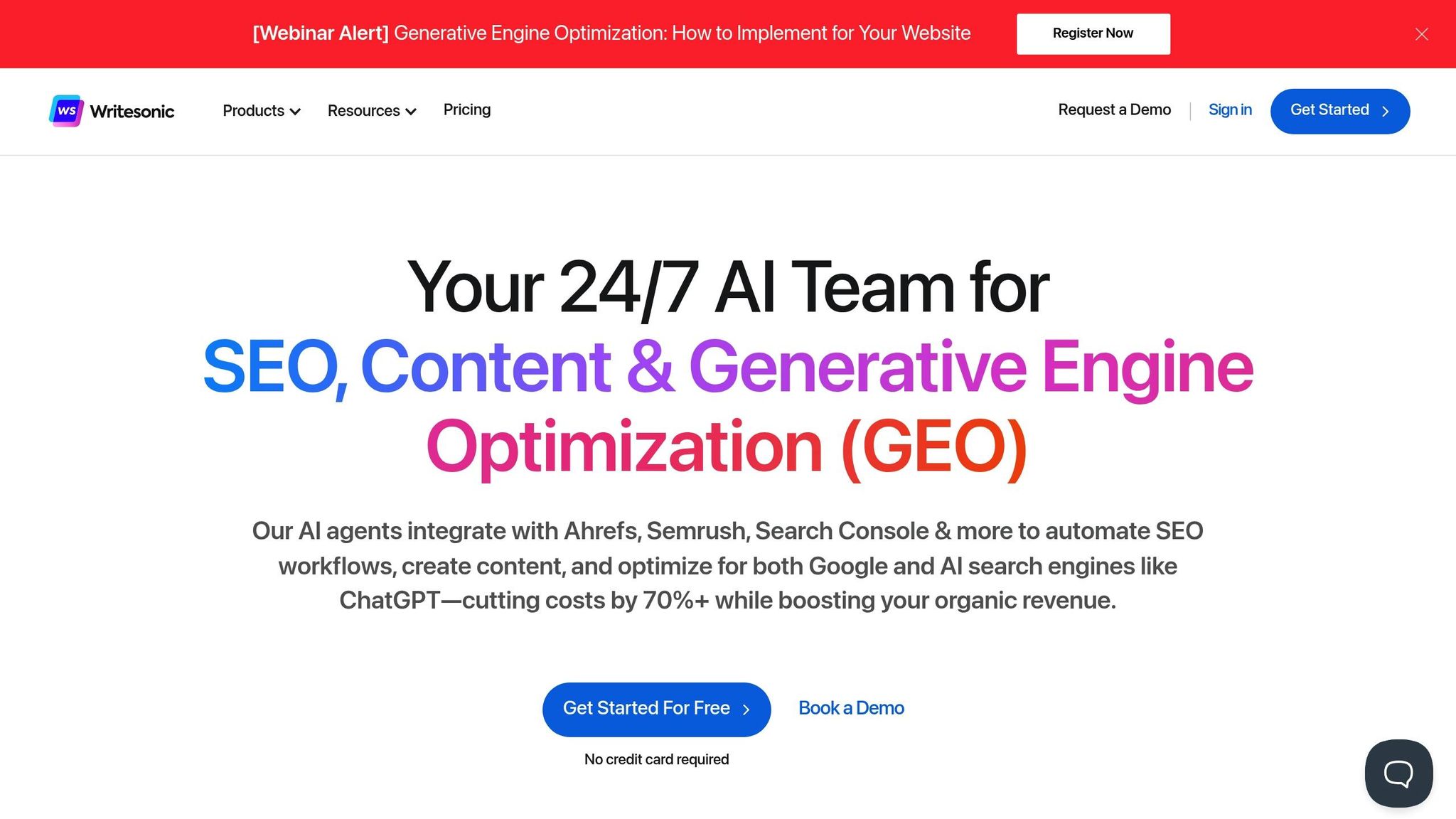
Text Generation and Enhancement
WriteSonic's Long-Form Assistant can generate 1,500-word essays in just 20 seconds using academic templates. Its Chatsonic feature adds an interactive Q&A element, helping users address knowledge gaps during the writing process. A 2024 study revealed that 73% of participants improved the quality of their essay drafts by using WriteSonic's brainstorming tools.
| Feature | Description |
|---|---|
| Generation Speed | 1,500 words in 20 seconds |
| Template Options | Over 80 content templates |
| Language Support | Available in 26 languages |
| Processing Capacity | Handles 2,000+ words per session |
Grammar and Style Checking
WriteSonic includes a basic grammar checker with an accuracy rate of 88%, making it useful for polishing early drafts. For academic writing, the "Premium" output mode offers higher-quality results.
Content Quality Management
WriteSonic is designed to maintain 94% content originality, thanks to its AI trained on licensed datasets. Its Brand Voice feature helps ensure a consistent academic tone throughout the content.
Tips for Academic Writing:
- Use the Thesis Statement Generator to create a solid foundation for essays.
- Turn on the Factual Content mode for data-focused introductions.
- Export drafts to Google Docs for easy collaboration.
- Always double-check sources, especially for niche or technical topics.
Pricing Options
WriteSonic offers flexible pricing plans to suit different needs:
| Plan | Monthly Cost | Key Features |
|---|---|---|
| Free | $0 | 25 monthly generations |
| Individual | $16 | 50 credits, 1 brand voice |
| Standard | $79 | AI keyword clusters, automated linking |
| Enterprise | Custom | Unlimited features, API access |
"Treat the AI output as a first draft - always fact-check and personalize the content."
This approach resonates with users, as 68% of students reported WriteSonic to be a cost-effective alternative to traditional tutoring services.
Tool Comparison Chart
Here’s a quick breakdown of some of the leading AI-powered essay writing tools, highlighting their features, pricing, and ideal use cases:
| Tool | Key Features | Plagiarism Check | Citation Tools | Free Option | Monthly Price (USD) | Best For |
|---|---|---|---|---|---|---|
| Yomu AI | Document Assistant, AI Autocomplete, Text Enhancement, Citation Tool | ✓ | ✓ | - | Contact Sales | Academic Writing |
| Grammarly | Grammar Checking, Style Suggestions, Tone Adjustment | ✓ | - | ✓ | $12-$30 | General Writing |
| QuillBot | Paraphrasing, Grammar Check, Citation Generator | ✓ | ✓ | ✓ | $14.99 | Research Papers |
| Scribbr | Citation Generator, Plagiarism Check, Proofreading | ✓ | ✓ | - | Custom Pricing | Academic Citations |
| ProWritingAid | Style Editor, Writing Analysis, Integration | ✓ | - | ✓ | $20 | Style Improvement |
| Jasper AI | Long-form Writing, Templates, Team Collaboration | - | - | 7-day trial | $49 | Professional Writing |
| Paperpile | Reference Management, PDF Annotation, Cloud Storage | - | ✓ | 30-day trial | $36 | Reference Management |
| Zotero | Bibliography Tools, Research Organization, Collaboration | - | ✓ | ✓ | Free | Research Organization |
| Turnitin | Originality Check, Grammar Check, Feedback Studio | ✓ | - | - | Custom Pricing | Plagiarism Detection |
| WriteSonic | AI Content Creation, Multilingual Support, Brand Voice | - | - | ✓ | $16-$79 | Content Generation |
Key Notes on Features:
- Pricing reflects basic subscription plans.
- Annual plans often include discounts.
- Enterprise pricing typically involves custom quotes.
- Free plans usually come with usage limits.
Tips for Choosing the Right Tool:
- Align the tool with your specific writing needs - whether academic, professional, or creative.
- Ensure compatibility with your preferred word processor.
- For academic work, prioritize tools with strong citation features.
- Take advantage of free trials or free plans to test functionality.
- Confirm language support if you’re working in multiple languages.
Up next, we’ll explore practical ways to incorporate these tools into your writing workflow.
How to Use AI Writing Tools Effectively
To make the most of AI writing tools while adhering to academic and professional standards, consider these strategies. These tips will help you maintain compliance and ensure your work reflects your personal voice.
Establish Clear Guidelines
Start by reviewing your institution's policies on AI usage to ensure your approach aligns with their standards. The Authors Guild offers this advice:
"To the extent you use AI to generate text, be sure to rewrite it in your own voice before adopting it. If you are claiming authorship, then you should be the author of your work."
Best Practices for AI-Assisted Writing
Review and Verify Content
Always double-check AI-generated content for accuracy. Confirm facts, statistics, and citations with reliable sources before including them in your work.
Maintain Your Voice
AI tools can help with drafting, but the final product should reflect your unique perspective. Here’s how to balance AI assistance with your personal input:
- Use AI to create an initial outline or draft.
- Review the draft for accuracy, tone, and flow.
- Add personal insights, examples, and adjustments to make it your own.
Academic and Professional Integration
When incorporating AI tools into your workflow, focus on transparency and proper application. Here’s a breakdown of how to use these tools effectively:
| Task | How to Use AI Tools | Important Notes |
|---|---|---|
| Research | Summarize initial findings | Independently verify sources |
| Outlining | Get structure suggestions | Adapt to your specific needs |
| Editing | Check grammar and style | Retain your unique tone |
| Citations | Generate preliminary entries | Confirm formatting accuracy |
Quality Control Measures
Content Verification
- Cross-check facts and statistics with primary sources.
- Ensure citations are up-to-date and correctly formatted.
- Confirm examples are relevant to your topic.
Style Consistency
- Keep the tone consistent throughout your work.
- Blend AI-generated content with your writing for a natural flow.
- Avoid over-reliance on AI to maintain originality.
Academic Integrity
Always follow your institution's rules for AI usage. If AI tools assist in your work, acknowledge their role as required. This approach ensures transparency while affirming your authorship.
Conclusion
AI essay writing tools can streamline the writing process for both students and professionals. To get the most out of these tools, it's important to choose one that fits your specific needs, whether that's research assistance, citation management, or plagiarism detection. Here's a quick guide to help you make informed decisions:
| Aspect | What to Look For | Tips for Best Use |
|---|---|---|
| Academic Integrity | Compliance with institutional policies | Double-check your institution's AI guidelines |
| Content Quality | Regular updates to the knowledge base | Ensure the tool is updated frequently (e.g., every 4 weeks) |
| Writing Support | Features that align with your needs | Pick tools that match your specific writing goals |
| Learning Value | Opportunities to build your skills | Use AI suggestions to enhance your own writing abilities |
These tools are most effective when used ethically and strategically. They should act as a supplement to, not a replacement for, your own critical thinking and creativity.
FAQs
How do AI tools help maintain academic integrity when writing essays?
AI essay writing tools promote academic integrity by offering features like plagiarism detection and citation management. These tools can check the originality of your work and ensure proper citation formatting, helping you adhere to academic standards.
By using these tools responsibly - as a support system rather than a replacement for original thinking - you can enhance your writing while avoiding unintentional plagiarism. Always review and refine AI-generated content to ensure it aligns with your unique voice and meets academic requirements.
What should I look for in an AI essay writing tool to meet my academic or professional needs?
When selecting an AI essay writing tool, focus on features that cater to your specific needs. Look for tools that provide grammar and style checks, content generation, and customization options like adjusting tone and format. These features ensure your writing aligns with academic or professional standards.
Efficiency is also key - choose a tool that automates tasks such as paraphrasing, grammar corrections, and citation management to save time. Additionally, prioritize tools with built-in plagiarism detection and citation support to maintain originality and integrity in your work.
What privacy and security measures do AI writing tools use to protect user data?
Privacy and security are critical when using AI writing tools. These tools often collect user data, such as email addresses or usage information, to improve functionality. However, it’s important to understand how your data is being handled and protected.
To safeguard your information, many tools implement encryption, anonymize data, and offer settings to control data sharing. To stay secure, always review the tool’s privacy policy, avoid sharing sensitive information, and use trusted platforms. While most tools strive for robust security, no system can guarantee 100% protection, so it’s wise to remain cautious.
